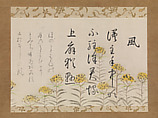Poems on “Wind” from Japanese and Chinese and Poems to Sing
Horie Yorinao (Tōgen) Japanese
Not on view
This section of a handscroll of Japanese and Chinese Poems to Sing (Wakan rōeishū) was brushed by Horie Tōgen (or Yorinao) a celebrated calligrapher of the late seventeenth century who served as local retainer (hanshi) of the daimyo clan that ruled the Marugame fief of Sanuki province (modern-day Kawagawa prefecture) on Shikoku. Even though raised in a samurai household, Tōgen practiced jōdaiyō, archaic script type harkening back to the peak of Heian-period court culture of the eleventh and twelfth century. He then developing his own distinctive handwriting style, as shown here that combines courtly elegance—without any cloying—and a certain bravado. The underpainting shows highly stylized maiden flowers (ominaeshi).
The two poems transcribed here belong a section of the Japanese and Chinese Poems to Sing anthology entitled “Wind” (Kaze 風), and comprises a couplet of seven-syllable Chinese verse, and a single waka (31-syllable court verse). The first poem, in archaic Chinese, was composed by not very well known courtier-scholar Fujiwara no Yukikatsu (Yukifuji, fl. ca. 960):
風
漢主手中吹不駐。徐君墓上扇猶懸。
Kaze
Kanshu no te no uchi ni fukite todomarazu
Jokun ga tsuka no ue ni ōgi de nao kakareri
Wind
In the hands of the ruler of Han,
it blows without ceasing:
Above the grave of Master Xu
it fans what hangs there still.
At first glance, the verse does not specifically mention “wind” but alludes to Gaozu, the founding emperor of the Han dynasty, was said to have wielded a “three-foot sword,” which he boasted allowed him to conquer all the Chinese empire; the wind here is compared to its sharpness. The second part of the couplet refers to sword left by Li Kong to dangle over the grave of his friend Xu Jun. Though not specifically mentioned, in the first line, the sword is a metaphor for the wind, and in the second line it fans the sword left dangling from the tree.
The Chinese verse is accompanied by a waka by courtier-poet Minamoto no Saneakira (910–970), who was later recognized as one of the Thirty-six Poetic Immortals, a roster of great poets of the Japanese literary tradition. The poem included selected here reads:
ほの/\と有明の月のつき影に
もみぢふきおろす山おろしの風
Honobono to
ariake no tsuki no
tsukikage ni
momiji fuki-orosu
yamaoroshi no kaze
Dimly, dimly,
in the moonlight
at the break of dawn,
crimson leaves flutter
in the wind from the hills.
(trans. John T. Carpenter)
The box is inscribed by the noted Nihonga painter Yasuda Yukihiko 安田靫彦 (1884–1978) attributing the painting to Ogata Kenzan (1663–1743), which is highly implausible, since the Rinpa artist would have been but eight years old when he did the scroll. The attribution was no doubt the result of the highly stylized manner of painting.
This image cannot be enlarged, viewed at full screen, or downloaded.
This artwork is meant to be viewed from right to left. Scroll left to view more.



